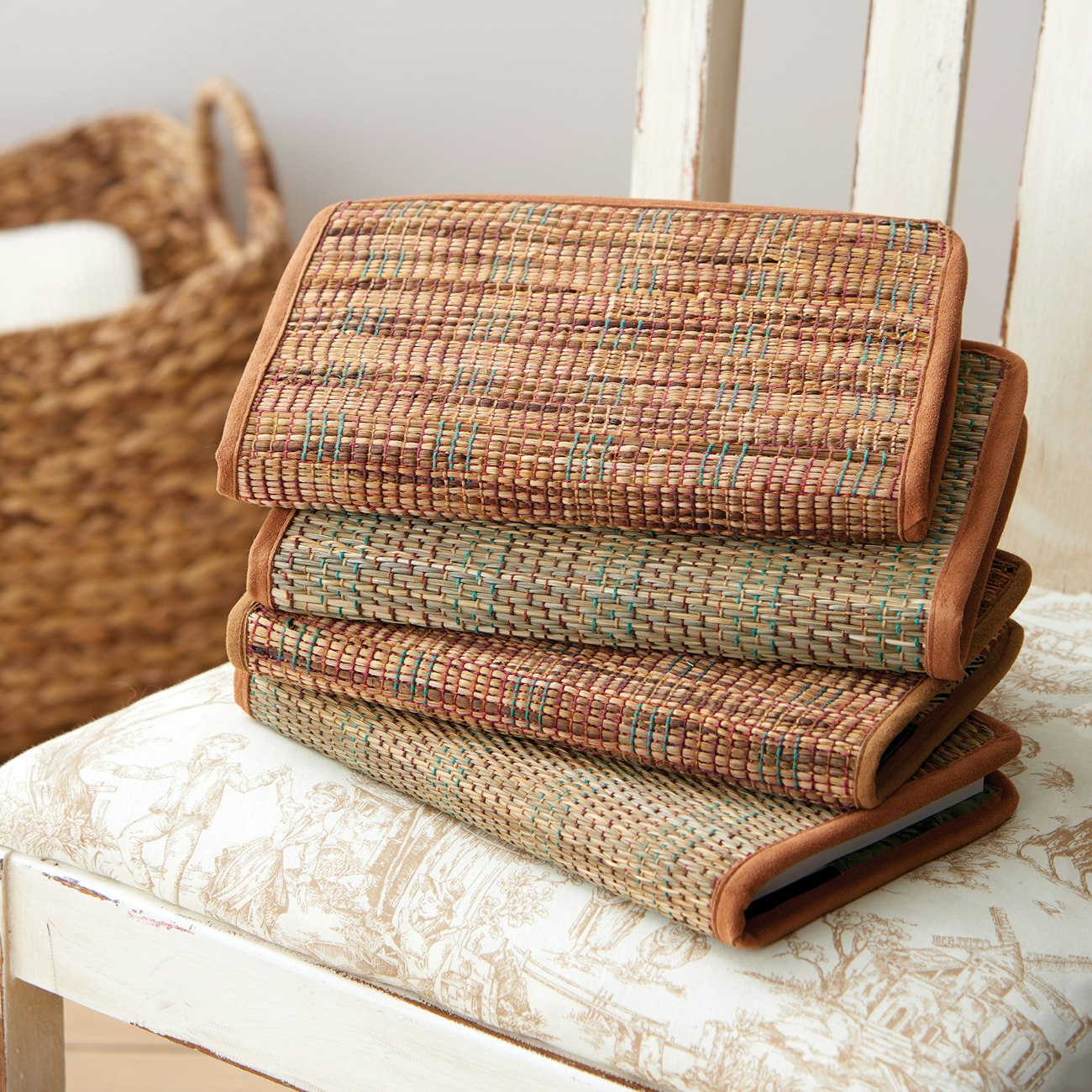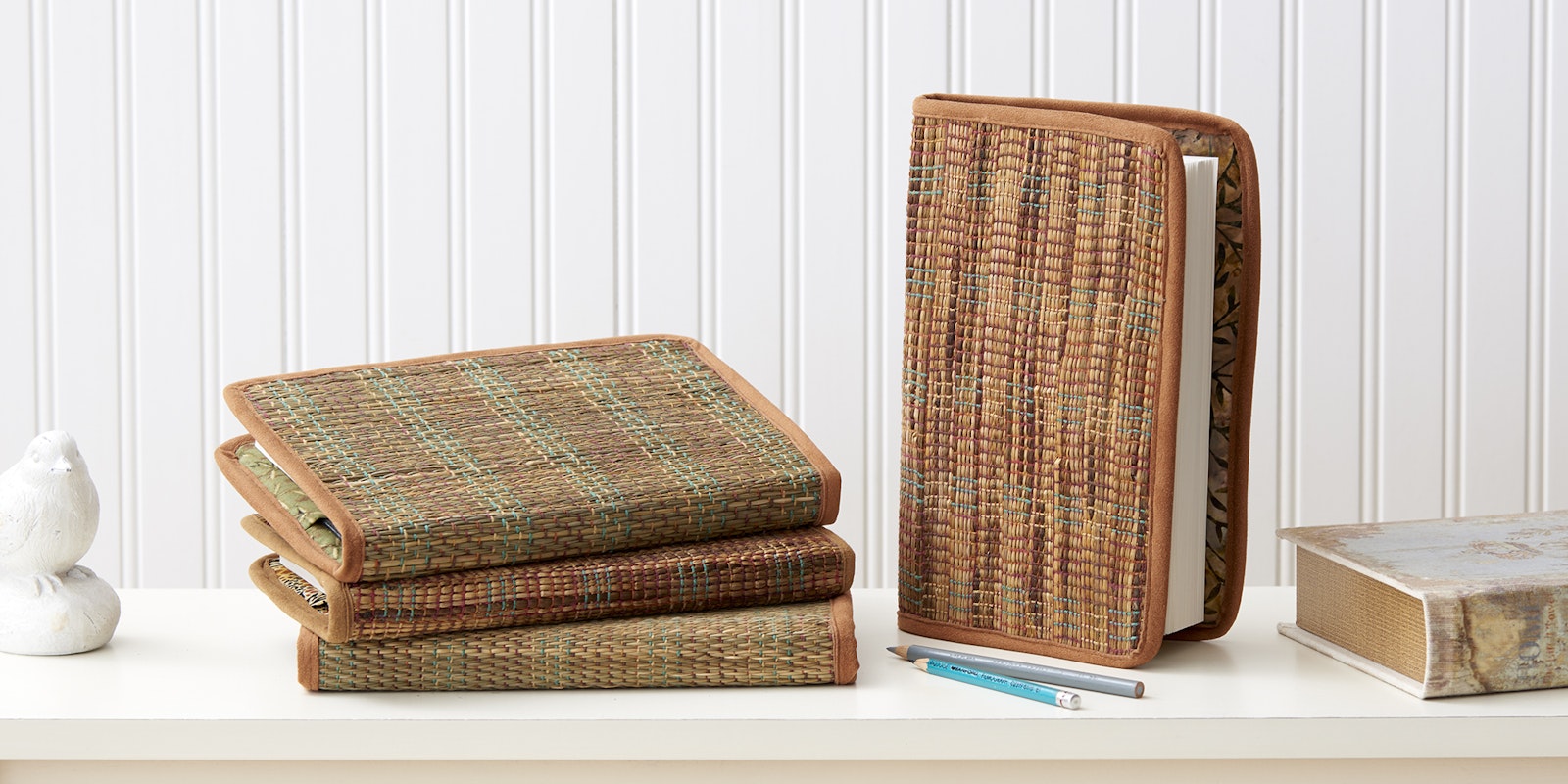Subscriber Exclusive
Weave with Leaves
Learn how to use daffodil stems, iris leaves, and even daylily leaves in your weaving.
Learn how to use daffodil stems, iris leaves, and even daylily leaves in your weaving. <a href="https://handwovenmagazine.com/weave-with-leaves-grasscloth-journals/">Continue reading.</a>
https://handwovenmagazine.com/cdn-cgi/image/format=auto/https://www.datocms-assets.com/75077/1706104385-grasscloth-journals-header.jpg?auto=format&w=900
Protect your books with this unique fiber! Photos by Donald Scott
One of the beautiful things about choosing wefts is that you don’t have to be nearly as picky as when selecting your warp. Singles, heavily textured yarns, and raffia can work as weft when paired with a strong warp. You can even use non-yarn materials as weft, including stems and leaves.
I know, weaving from the garden sounds a bit wild. Still, when prepared correctly, these weft materials make for beautiful, durable cloth that makes excellent runners, placemats, and book covers, as Patricia Morton did with her fabric. These wefts can be used on floor looms and rigid-heddle looms, which is always a bonus. Want to know more about her process for successfully weaving with stems and leaves as weft? You’re in luck! We’ve got information on how to prepare the fibers and a few project ideas below!
 Handwoven covers and journals make great gifts!
Handwoven covers and journals make great gifts!
How to Harvest and Dry Leaves for Weft
The stems of daffodils and the leaves of Siberian and Flag iris work well for grasscloth. It is best to harvest daffodil stems soon after the blossoms fade, and cut iris leaves while mature, but still green.
Clean the leaves by washing them in a sink or tub with warm water, a squirt of dish soap, and ¼ cup of bleach. Swish for a minute, and rinse with clear water. Be sure to wear rubber gloves and eye protection.
Spread the leaves to dry in thin layers on newspapers or old window screens, with each layer stacked at 90 degrees to the one below. Alternatively, you can hang them in bundles to dry in a barn or well-ventilated attic. Secure about 30 leaves very tightly with a rubber band at one end, and hang. The leaves take 1 to 4 weeks to dry. The leaves are fragile when dry, so handle them with care.
Once dry, store the leaves in paper.
Now that your leaves are prepared, test them out with a fun project. Download the 4-shaft and rigid-heddle instructions for the journal covers below, or check out the Daylily Mats by Melissa Schubert for another pattern idea.
Grasscloth Journal Covers Pattern Download
This project download includes two types of journal covers. The plain-weave journal covers, with their subtle log-cabin effect, can be woven on a rigid-heddle or 4-shaft loom. Four shafts are better for weaving the 2/2 twill version.
SUBSCRIBER EXCLUSIVE
Unlock the Full Article with a Handwoven Subscription
Get instant access to this article and the entire Handwoven library of weaving projects, techniques, and expert instruction. With your subscription, you’ll receive:
Step-by-step project guides
Skill-building tutorials and design inspiration
Access to premium weaving content, updated regularly
Handwoven Magazine
Whether you’re a beginner or a seasoned weaver, a Handwoven subscription helps you grow your skills and creativity.
Plans start at just $4.99/month. Cancel anytime.
One of the beautiful things about choosing wefts is that you don’t have to be nearly as picky as when selecting your warp. Singles, heavily textured yarns, and raffia can work as weft when paired with a strong warp. You can even use non-yarn materials as weft, including stems and leaves.
I know, weaving from the garden sounds a bit wild. Still, when prepared correctly, these weft materials make for beautiful, durable cloth that makes excellent runners, placemats, and book covers, as Patricia Morton did with her fabric. These wefts can be used on floor looms and rigid-heddle looms, which is always a bonus. Want to know more about her process for successfully weaving with stems and leaves as weft? You’re in luck! We’ve got information on how to prepare the fibers and a few project ideas below!
 Handwoven covers and journals make great gifts!
Handwoven covers and journals make great gifts!
How to Harvest and Dry Leaves for Weft
The stems of daffodils and the leaves of Siberian and Flag iris work well for grasscloth. It is best to harvest daffodil stems soon after the blossoms fade, and cut iris leaves while mature, but still green.
Clean the leaves by washing them in a sink or tub with warm water, a squirt of dish soap, and ¼ cup of bleach. Swish for a minute, and rinse with clear water. Be sure to wear rubber gloves and eye protection.
Spread the leaves to dry in thin layers on newspapers or old window screens, with each layer stacked at 90 degrees to the one below. Alternatively, you can hang them in bundles to dry in a barn or well-ventilated attic. Secure about 30 leaves very tightly with a rubber band at one end, and hang. The leaves take 1 to 4 weeks to dry. The leaves are fragile when dry, so handle them with care.
Once dry, store the leaves in paper.
Now that your leaves are prepared, test them out with a fun project. Download the 4-shaft and rigid-heddle instructions for the journal covers below, or check out the Daylily Mats by Melissa Schubert for another pattern idea.
Grasscloth Journal Covers Pattern Download
This project download includes two types of journal covers. The plain-weave journal covers, with their subtle log-cabin effect, can be woven on a rigid-heddle or 4-shaft loom. Four shafts are better for weaving the 2/2 twill version. [PAYWALL]
Warping the loom for these journal covers takes no time: it’s a sparse warp, and any fine cellulose yarn works. The nice thing about weaving grasscloth is that, for once, you need not worry about selvedges: they will be cut off!
Enjoy weaving these journal covers using the loom of your choice with this Subscriber Exclusive. Click here to get the PDF download of A Touch of Summer Grasscloth Journal Covers.
Download PDF
 Handwoven covers and journals make great gifts!
Handwoven covers and journals make great gifts!
